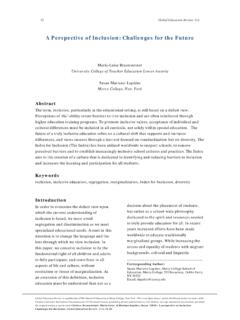Transcription of Culture Differences and English Teaching
1 English Language Teaching Vol. 4, No. 2; June 2011. Culture Differences and English Teaching Jin Wang Luohe Medical College Daxue Road, Luohe, Henan 462000, China E-mail: Received: January 10, 2011 Accepted: January 30, 2011 Abstract Language is a part of Culture , and plays a very important role in the development of the Culture . Some sociologists consider it as the keystone of Culture . They believe, without language, Culture would not be available. At the same time, language is influenced and shaped by Culture , it reflects Culture . Therefore, Culture plays a very important part in language Teaching , which is widely acknowledged by English Teaching circle. This thesis depicts the relationship between Culture and language. As a result, the gap of cultural Differences is one of the most important barriers in English Teaching and study. Among the students, lacking of cultural background knowledge can, to a great extent, hold up the improvement of English Teaching and become a noticeable problem.
2 At present, the objective of English Teaching has broken free from the traditional listening, speaking, reading and writing, and the demand for cultural background knowledge in language learning has been gradually concerned. Presentation of history of the country which has the target language, cultural background knowledge and customs is the proposed solution to the problem. This paper mainly discusses how to present cultural background knowledge and expose learners to it in the need of English Teaching at Chinese schools so as to solve the problems caused by cultural Differences , help learners grasp the crux of the language and develop their comprehensive English ability. Keywords: cultural background knowledge, cultural Differences , English Teaching 1. Introduction The linguist Robert Lado defines the goal of learning a foreign language as the ability to use it, understanding its meanings and connotations in terms of the target language and Culture , and the ability to understand the speech and writing of natives of the target Culture in terms of their great ideas and achievement (Lado, 1964: 25) Therefore, the English Teaching inevitably involves the Culture Teaching of target language.
3 With China's open-up policy and entry in WTO, how to lay a solid foundation for cultivating learners becomes an important objective in Teaching English as a foreign language. In traditional Teaching , though students master the pronunciation, grammar, vocabularies and a lot of skills about listening, speaking, reading, writing and translating, they still can not be said to fully understand and master English . English , as a foreign language, is the unity of the language itself and Culture . One purpose of English Teaching is to develop learners' awareness of cultural Differences reflected in languages. The teacher must help learners to realize that thoughts and views of different nationalities and different types of societies about nature and human society are quite different. Therefore, it is of great importance to take for cultural background knowledge as one of the contents in the whole process of English Teaching so as to help students to have a good command of necessary cultural background knowledge and to develop their comprehensive English ability.
4 Though Culture instruction may not be new to most English teachers in an examination-oriented environment in China, the research and practice of English Teaching in China still have a long way to go before they reach satisfactory results. This paper, therefore, aims to present what most actual practice in the classroom are needed to be clarified before anything can be done to improve future practice. There are three major parts in the paper: firstly, it is the literature review, which consists of the relation of Culture and Teaching , traditional and current situation of English Teaching in China. Secondly, the extent to how to present cultural background knowledge and expose learners to it in the need of English Teaching so as to help learners grasp the crux of the language and develop their comprehensive English ability, followed by the introduction of some of such techniques. Finally the model of classroom practices was proposed by the Teaching Culture . 2. English Teaching in China Traditional English Teaching in China In traditional English Teaching in China, English is considered as a sequence of phonetics, grammar and vocabulary, neglecting cultural knowledge input.
5 This usually causes cultural breakdowns. As communication between China Published by Canadian Center of Science and Education 223. English Language Teaching Vol. 4, No. 2; June 2011. and western countries is becoming closer, cultural factors should be paid enough attention. Current English Teaching in China China boasts the world's biggest population of English learners. The English course has been one of the most important compulsory subjects in China from primary schools to universities. We should get rid of traditional Teaching methods, and introduce more Culture background knowledge. It is impossible to introduce all knowledge of British and American Culture even by all kinds of approaches of Culture introduction. In English Teaching , teachers should take one step at a time to impart cultural knowledge from the shallower to the deeper, from the easier to the more advanced. Approaches of cultural introduction in English Teaching , of course, can be varied. Any approach, which accelerates students to grasp the knowledge of English the language itself - and Culture so as to improve their comprehensive English capability, should be adopted.
6 3. Culture Differences between China and America Culture What's Culture ? There are many definitions of Culture . Culture is a system of shared beliefs, values, customs, behaviors and artifacts that the members of a society use to cope with. Their world and with one another, and that are transmitted from generation to generation through learning ; Culture consists of all the shared products of human society (Robertson1981:67). This means not only such visible things as cities, organizations and schools, but also non-material things such as ideas, customs, family patterns, languages. To simplify, Culture refers to the entire way of life of a society, the ways of a people.. Typical Culture in China Traditional Chinese Culture has varied gradually over a long historical period into a form of national spirit manifested in group loyalty. It expresses itself in the modes of thinking and behavior, in the national temperament and in other aspects of Culture still perceptibly influential today.
7 Generally speaking, the traditional Chinese Culture values can be summed up as follows: Collectivism, Harmony, Hierarchy, Humility and Courtesy. Collectivism and Harmony A key belief of people in collectivist cultures is that the smallest unit of survival is the collective or group (Zhang2003:54). Chinese Culture is characterized as being collectivism orientated. The basic unit is the family (collective), not the individual. It is sometimes referred to as a collective or group Culture . Filial piety is one of the principal virtues counseled by Confucius; this is not an abstraction but one that manifests itself daily by children and adults demonstrating their obedience and solicitousness towards their parents and solicitous of their welfare. Family support is rated highly by all. Family support necessitates cooperation with others. Therefore, harmony is highly valued and conflicts are avoided. Competition is not encouraged. One important way to achieve harmony is to accept and respect each person's need to preserve face.
8 Hierarchy and Humility Another key characteristic of Chinese Culture is hierarchy. People have to accept their social position both family and society in order to achieve social harmony. Confucius wrote Let the emperor be an emperor, the subject a subject, the father a father, and the son a son . This implies that within the family as within the nation, people were not equal. He acknowledged inequality because in his view, the obligations between higher and lower orders in society worked in both directions. Each had a duty towards the other. Throughout Chinese history people have shown respect for seniority, rank, age and family with a hierarchical perspective. Courtesy/Good Manners As harmony is desired in a hierarchical society, courtesy has always played a key role in Chinese Culture when interacting with people. Humility manifests itself in daily life, and often without our awareness. It often takes the form of self-disparagement. Typical Culture in America American Culture has been viewed as cultural pluralism.
9 Throughout American history there has been diversity shown by the cultures of the differing Native American tribes, Spanish settlers in the south-west and Florida, African slaves, French traders and British colonialists. Over two hundred years, immigration has increased that diversification. The American Culture is often referred to as an individualistic Culture where individuals subordinate the goals of collectives to their personal goals. Six core values or beliefs have evolved as traditional American values: freedom of the individual, self-reliance, equality of opportunity, competition, the desire for material wealth 224 ISSN 1916-4742 E-ISSN 1916-4750. English Language Teaching Vol. 4, No. 2; June 2011. and hard work. Individual Freedom and Self-Reliance Due to limitation of the power of Government, Church and absence of Aristocracy, the early settlers created a climate of freedom with emphasis on the individual. The new independent United States (post 1776) instilled the concept of individual freedom, probably the most basic of American values.
10 A key belief of people in individualistic cultures is that the smallest unit of survival is the individual. American Culture is sometimes referred to as the I . Culture since it is the individual rather than the group which is emphasized. Freedom for Americans means the right of all individuals to control their own destiny without outside interference from government, a ruling class, church or other organized authority. A price is however paid for individual freedom: self-reliance. This often means achieving financial and emotional independence from parents at the earliest time possible. The need to stand on theirs own feet is considered a priority. Equality of Opportunity and Competition President Lincoln expressed the value of equality of opportunity . Americans understand this as the right to have equal chance for success in life but not that everyone is or should be equal. They see life as a race for success. Equality means that everyone should have an equal chance to enter the race and win.















